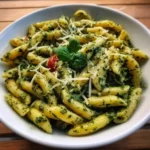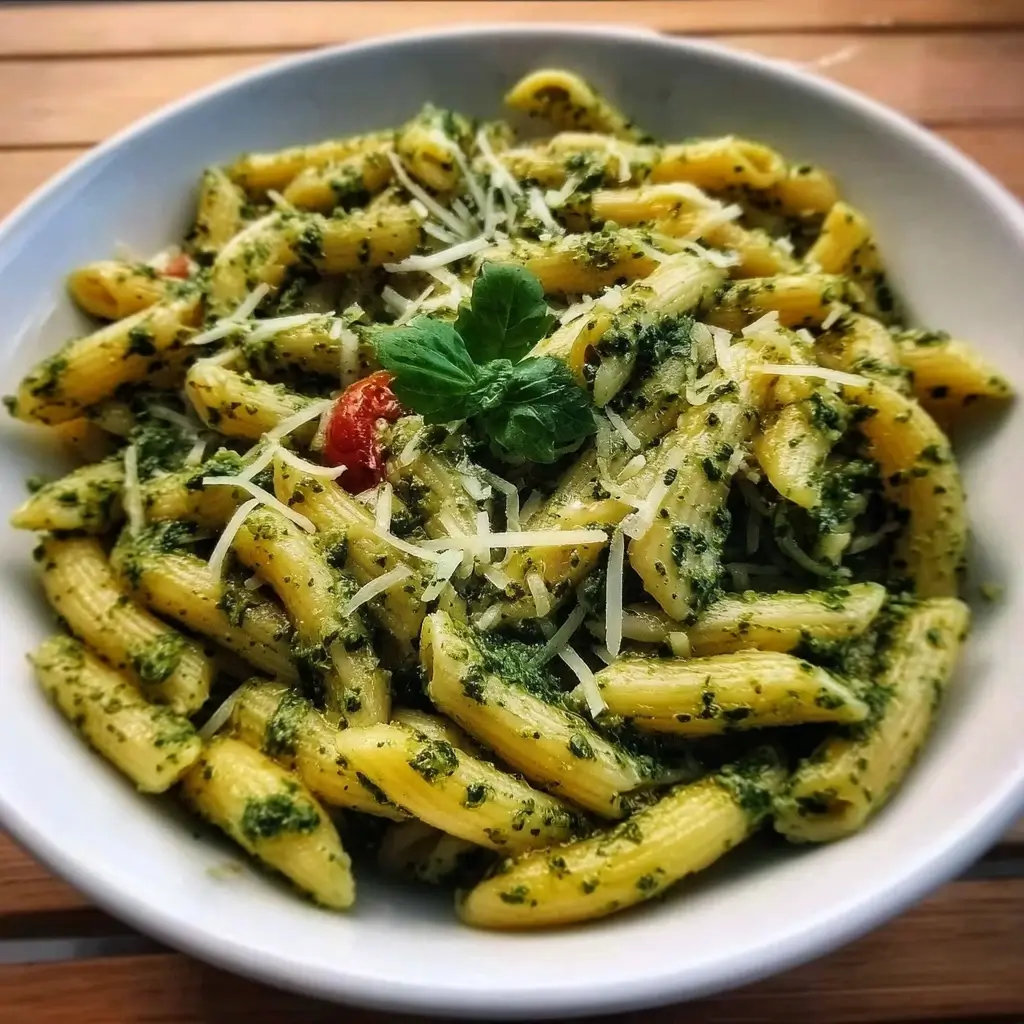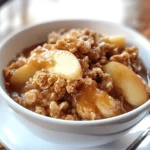Of all the quick weeknight dinners in my rotation, this vibrant Spinach Pesto Pasta holds a special place in my heart and my recipe book. I remember the first time I made it, I was staring at a fridge with a looming bag of fresh spinach that was nearing its end, and a pantry with the usual staples. I was tired, the family was hungry, and the thought of an elaborate meal was exhausting. On a whim, I decided to blend the spinach into a pesto instead of the usual basil. The result was nothing short of a revelation. The color was an electric, jewel-toned green that instantly made the dish look gourmet. The flavor was fresher, earthier, and milder than traditional pesto, which was a huge hit with my kids who sometimes find basil a bit too strong. When I tossed the creamy, emerald sauce with hot pasta, the whole family gathered around the kitchen island, drawn in by the incredible aroma. It was devoured in minutes, with requests for seconds all around. Now, it’s our go-to “fancy” meal that secretly takes less than 30 minutes to whip up, proving that sometimes the best recipes are born from necessity and a little bit of kitchen creativity.
The Ultimate Spinach Pesto Pasta: A Guide to Your New Favorite Meal
Welcome to the definitive guide for making the most luscious, flavorful, and brilliantly green Spinach Pesto Pasta you’ve ever tasted. This isn’t just a recipe; it’s a technique that will transform your view of homemade pesto. We’ll dive deep into why each ingredient is chosen, how to execute each step perfectly, and how to customize this dish to make it uniquely yours. Forget the jarred stuff—this homemade version is packed with nutrients, fresh flavor, and a creamy texture that is simply unparalleled. It’s a perfect dish for a busy weeknight, a healthy lunch, or an impressive meal for guests.
Ingredients: The Building Blocks of Flavor
For this recipe, quality matters. Using fresh and flavorful ingredients will elevate your pesto from good to unforgettable. Here’s what you’ll need:
- Fresh Baby Spinach (5 oz / 150g): The star of the show. Use fresh, pre-washed baby spinach for a mild, sweet flavor and tender texture. It wilts and blends beautifully.
- Pasta (1 lb / 450g): Your choice of pasta. Long strands like spaghetti or fettuccine are classic, but short shapes like fusilli, penne, or orecchiette are excellent at trapping the pesto in their nooks and crannies.
- Walnuts (1/2 cup / 60g): Toasted. Walnuts provide a rich, earthy creaminess that complements the spinach perfectly. Toasting them first is a non-negotiable step for releasing their aromatic oils and deepening their flavor.
- Parmesan Cheese (1/2 cup / 50g): Freshly grated. Please, skip the pre-shredded kind. A block of Parmigiano-Reggiano will melt into the sauce and provide a sharp, nutty, and salty bite that is essential.
- Garlic (2-3 cloves): Freshly minced or roughly chopped. Adjust to your personal taste. For a milder garlic flavor, you can briefly blanch the cloves with the spinach.
- Extra Virgin Olive Oil (1/2 cup / 120ml): The binder. A good quality, flavorful extra virgin olive oil will bring all the ingredients together and create a smooth, emulsified sauce.
- Lemon Juice (1 tablespoon): Freshly squeezed. This is the secret weapon. A splash of lemon juice brightens all the flavors, cuts through the richness of the oil and nuts, and helps keep the pesto’s vibrant green color.
- Salt (1 teaspoon, plus more for pasta water): To taste. Essential for seasoning the pasta water and balancing the flavors in the pesto.
- Black Pepper (1/2 teaspoon): Freshly ground. For a touch of warmth and spice.
- Reserved Pasta Water (about 1 cup): The magic ingredient. The starchy, salty water from cooking the pasta is crucial for turning your pesto into a creamy, luscious sauce that clings perfectly to every noodle.
Instructions: A Step-by-Step Path to Perfection
Follow these detailed steps to ensure your spinach pesto pasta is flawless every single time. The process is simple, but attention to detail makes all the difference.
- Toast the Walnuts: Place a dry, small skillet over medium heat. Add the walnuts and toast for 4-6 minutes, tossing frequently, until they are fragrant and slightly browned. Be very careful not to burn them, as they can turn bitter quickly. Once toasted, remove them from the skillet immediately and set them aside to cool. This step is crucial for developing a deep, nutty flavor.
- Cook the Pasta: Bring a large pot of water to a rolling boil. Add a generous amount of salt (it should taste like the sea). This is your only chance to season the pasta itself. Add your chosen pasta to the boiling water and cook according to the package directions until it is al dente—cooked through but still with a firm bite.
- Blanch the Spinach (Optional but Recommended): While the pasta is cooking, you can perform this quick step for the most vibrant green pesto. About 2 minutes before the pasta is done, add the fresh spinach directly to the pot with the pasta. Let it wilt for about 30-45 seconds. This quick blanching process locks in the bright green color and mellows the spinach flavor slightly. Use a slotted spoon or spider strainer to remove the spinach and immediately transfer it to a colander. Gently press out as much excess water as you can.
- Prepare the Pesto: In the bowl of a food processor or a high-powered blender, combine the cooled toasted walnuts, the roughly chopped garlic, and the freshly grated Parmesan cheese. Pulse a few times until the mixture is broken down into a coarse meal.
- Blend the Sauce: Add the blanched (and squeezed) spinach and the fresh lemon juice to the food processor. Pulse again until the spinach is well incorporated. With the food processor running on low, slowly stream in the extra virgin olive oil. Continue to process until the pesto is smooth and emulsified. Scrape down the sides of the bowl as needed to ensure everything is evenly blended. Season with salt and freshly ground black pepper, and pulse one last time to combine. Give it a taste and adjust seasoning if necessary.
- Combine and Serve: Before you drain the pasta, carefully reserve about 1-2 cups of the starchy pasta water. Drain the cooked pasta well. Return the hot pasta to the pot you cooked it in (off the heat). Add about half of your freshly made spinach pesto to the pasta and begin to toss. Add a splash (about 1/4 cup) of the reserved pasta water. The heat from the pasta and the starch from the water will help emulsify the oil in the pesto, creating an incredibly creamy sauce that coats every piece of pasta without being oily. Continue to add more pesto and pasta water, a little at a time, until the pasta is coated to your liking.
- Final Touches: Serve the pasta immediately in warm bowls. Garnish with a sprinkle of extra grated Parmesan cheese, a few toasted walnuts, and a drizzle of good quality olive oil.
Nutrition Facts
This is an estimate, and actual values can vary based on specific ingredients and portion sizes.
- Servings: 6
- Calories per Serving: Approximately 550-600 kcal
- Healthy Fats: This dish is rich in monounsaturated fats from olive oil and polyunsaturated fats (including omega-3s) from walnuts. These fats are crucial for heart health and reducing inflammation.
- Vitamin K: Spinach is a powerhouse of Vitamin K, which is essential for bone health and proper blood clotting.
- Fiber: Using whole wheat pasta and including spinach and walnuts makes this dish a good source of dietary fiber, which aids in digestion and helps you feel full and satisfied.
Preparation Time
This recipe is designed for efficiency, making it a perfect weeknight meal.
- Total Time: 25-30 minutes
- Prep Time: 10 minutes (toasting nuts, gathering ingredients)
- Cook Time: 15-20 minutes (boiling water, cooking pasta, blending pesto)
How to Serve
This Spinach Pesto Pasta is a fantastic standalone meal, but it can also be the star of a larger spread. Here are some ideas for serving:
- Garnishes are Key: Elevate the presentation and flavor with thoughtful garnishes.
- A generous sprinkle of extra freshly grated Parmesan cheese.
- A handful of chopped, toasted walnuts for a delightful crunch.
- A small dollop of creamy ricotta cheese on top for extra richness.
- A sprinkle of red pepper flakes for a kick of heat.
- Freshly cracked black pepper and a final drizzle of high-quality extra virgin olive oil.
- Add a Protein Boost: This vegetarian dish is easily adaptable.
- Toss in some grilled, shredded chicken for a classic combination.
- Add pan-seared shrimp or scallops for a delicious seafood twist.
- Crumble in some savory pan-fried beef for a heartier meal.
- For a plant-based protein, add a can of drained and rinsed chickpeas or some crispy pan-fried tofu.
- Perfect Side Dishes: Complement the pasta with a fresh side.
- A simple Caprese salad with fresh tomatoes, mozzarella, and basil.
- A crisp green salad with a light vinaigrette to cut through the richness of the pesto.
- A side of garlic bread or crusty bread for soaking up any leftover sauce.
- Roasted vegetables like cherry tomatoes, bell peppers, or zucchini add color and nutrients.
Additional Tips for Pesto Perfection
Take your spinach pesto to the next level with these five professional tips.
- Always Toast Your Nuts: This is the most important tip for flavor. Toasting nuts (whether they’re walnuts, pine nuts, or almonds) releases their natural oils, making them more aromatic and intensely flavorful. It transforms them from a simple textural element into a key flavor component of your pesto.
- The Magic of Blanching: For the most vividly green pesto that resists browning, blanch your spinach. A quick 30-second dip in boiling water followed by a squeeze to remove moisture locks in the chlorophyll. It also tames any potential bitterness from more mature spinach, resulting in a smoother, sweeter sauce.
- Don’t Discard the Pasta Water: This starchy, salty liquid is liquid gold. When you combine the pesto with hot pasta, the oil can separate. The emulsifiers in the pasta water bind the oil and water together, creating a silky, restaurant-quality sauce that perfectly clings to the noodles rather than pooling at the bottom of the bowl.
- Control the Garlic: Raw garlic can be overpowering and sometimes develop a harsh, bitter flavor in pesto. To mellow it out, you can either use fewer cloves or blanch the cloves along with the spinach for 30 seconds. This will give you a sweeter, more roasted garlic flavor profile.
- Proper Pesto Storage: If you have leftover pesto, store it in an airtight container or jar. To prevent the top layer from oxidizing and turning brown, pour a thin layer of olive oil over the surface before sealing the container. This creates a barrier against the air. It will keep in the refrigerator for up to a week.
Frequently Asked Questions (FAQ)
Here are answers to some common questions about making spinach pesto pasta.
1. Can I make this spinach pesto nut-free?
Absolutely. For a nut-free version, you can substitute the walnuts with an equal amount of raw, shelled sunflower seeds or pumpkin seeds (pepitas). Be sure to toast them just as you would the nuts to bring out their flavor. This is an excellent option for those with nut allergies.
2. My pesto tastes slightly bitter. What went wrong?
Bitterness in pesto can come from a few sources. The most common culprit is over-processing the olive oil in the food processor, which can break down the polyphenols and create a bitter taste. To avoid this, blend all other ingredients first, then stream in the oil slowly at the very end, mixing just until emulsified. Another cause could be using older or slightly bitter spinach, or not toasting the nuts, which can have a raw, bitter edge.
3. Can I use frozen spinach instead of fresh?
Yes, you can use frozen spinach in a pinch. You will need to thaw it completely and then squeeze out as much water as physically possible. Excess water is the enemy of good pesto and will result in a diluted, watery sauce. Use about 1 cup of thawed, well-squeezed frozen spinach as a substitute for the 5 oz of fresh spinach.
4. How can I make this recipe vegan?
This recipe is very easy to make vegan! The only non-vegan ingredient is the Parmesan cheese. Simply substitute it with a high-quality vegan Parmesan alternative or use 1/4 cup of nutritional yeast. Nutritional yeast will provide a cheesy, umami-rich flavor that works beautifully in pesto. Ensure your chosen pasta is also egg-free.
5. Can I make the pesto ahead of time?
Yes, making the pesto ahead of time is a fantastic meal-prep strategy. You can prepare the pesto and store it in an airtight container in the refrigerator for up to 5 days (cover the surface with olive oil to prevent browning). You can also freeze it for longer-term storage. A great method is to freeze the pesto in ice cube trays. Once frozen, pop out the pesto cubes and store them in a freezer bag. This allows you to thaw just the amount you need for a quick and easy meal anytime.

Spinach Pesto Pasta
- Total Time: 30 minutes
Ingredients
For this recipe, quality matters. Using fresh and flavorful ingredients will elevate your pesto from good to unforgettable. Here’s what you’ll need:
- Fresh Baby Spinach (5 oz / 150g): The star of the show. Use fresh, pre-washed baby spinach for a mild, sweet flavor and tender texture. It wilts and blends beautifully.
- Pasta (1 lb / 450g): Your choice of pasta. Long strands like spaghetti or fettuccine are classic, but short shapes like fusilli, penne, or orecchiette are excellent at trapping the pesto in their nooks and crannies.
- Walnuts (1/2 cup / 60g): Toasted. Walnuts provide a rich, earthy creaminess that complements the spinach perfectly. Toasting them first is a non-negotiable step for releasing their aromatic oils and deepening their flavor.
- Parmesan Cheese (1/2 cup / 50g): Freshly grated. Please, skip the pre-shredded kind. A block of Parmigiano-Reggiano will melt into the sauce and provide a sharp, nutty, and salty bite that is essential.
- Garlic (2-3 cloves): Freshly minced or roughly chopped. Adjust to your personal taste. For a milder garlic flavor, you can briefly blanch the cloves with the spinach.
- Extra Virgin Olive Oil (1/2 cup / 120ml): The binder. A good quality, flavorful extra virgin olive oil will bring all the ingredients together and create a smooth, emulsified sauce.
- Lemon Juice (1 tablespoon): Freshly squeezed. This is the secret weapon. A splash of lemon juice brightens all the flavors, cuts through the richness of the oil and nuts, and helps keep the pesto’s vibrant green color.
- Salt (1 teaspoon, plus more for pasta water): To taste. Essential for seasoning the pasta water and balancing the flavors in the pesto.
- Black Pepper (1/2 teaspoon): Freshly ground. For a touch of warmth and spice.
- Reserved Pasta Water (about 1 cup): The magic ingredient. The starchy, salty water from cooking the pasta is crucial for turning your pesto into a creamy, luscious sauce that clings perfectly to every noodle.
Instructions
Follow these detailed steps to ensure your spinach pesto pasta is flawless every single time. The process is simple, but attention to detail makes all the difference.
- Toast the Walnuts: Place a dry, small skillet over medium heat. Add the walnuts and toast for 4-6 minutes, tossing frequently, until they are fragrant and slightly browned. Be very careful not to burn them, as they can turn bitter quickly. Once toasted, remove them from the skillet immediately and set them aside to cool. This step is crucial for developing a deep, nutty flavor.
- Cook the Pasta: Bring a large pot of water to a rolling boil. Add a generous amount of salt (it should taste like the sea). This is your only chance to season the pasta itself. Add your chosen pasta to the boiling water and cook according to the package directions until it is al dente—cooked through but still with a firm bite.
- Blanch the Spinach (Optional but Recommended): While the pasta is cooking, you can perform this quick step for the most vibrant green pesto. About 2 minutes before the pasta is done, add the fresh spinach directly to the pot with the pasta. Let it wilt for about 30-45 seconds. This quick blanching process locks in the bright green color and mellows the spinach flavor slightly. Use a slotted spoon or spider strainer to remove the spinach and immediately transfer it to a colander. Gently press out as much excess water as you can.
- Prepare the Pesto: In the bowl of a food processor or a high-powered blender, combine the cooled toasted walnuts, the roughly chopped garlic, and the freshly grated Parmesan cheese. Pulse a few times until the mixture is broken down into a coarse meal.
- Blend the Sauce: Add the blanched (and squeezed) spinach and the fresh lemon juice to the food processor. Pulse again until the spinach is well incorporated. With the food processor running on low, slowly stream in the extra virgin olive oil. Continue to process until the pesto is smooth and emulsified. Scrape down the sides of the bowl as needed to ensure everything is evenly blended. Season with salt and freshly ground black pepper, and pulse one last time to combine. Give it a taste and adjust seasoning if necessary.
- Combine and Serve: Before you drain the pasta, carefully reserve about 1-2 cups of the starchy pasta water. Drain the cooked pasta well. Return the hot pasta to the pot you cooked it in (off the heat). Add about half of your freshly made spinach pesto to the pasta and begin to toss. Add a splash (about 1/4 cup) of the reserved pasta water. The heat from the pasta and the starch from the water will help emulsify the oil in the pesto, creating an incredibly creamy sauce that coats every piece of pasta without being oily. Continue to add more pesto and pasta water, a little at a time, until the pasta is coated to your liking.
- Final Touches: Serve the pasta immediately in warm bowls. Garnish with a sprinkle of extra grated Parmesan cheese, a few toasted walnuts, and a drizzle of good quality olive oil.
- Prep Time: 10 minutes
- Cook Time: 20 minutes
Nutrition
- Serving Size: one normal portion
- Calories: 600






